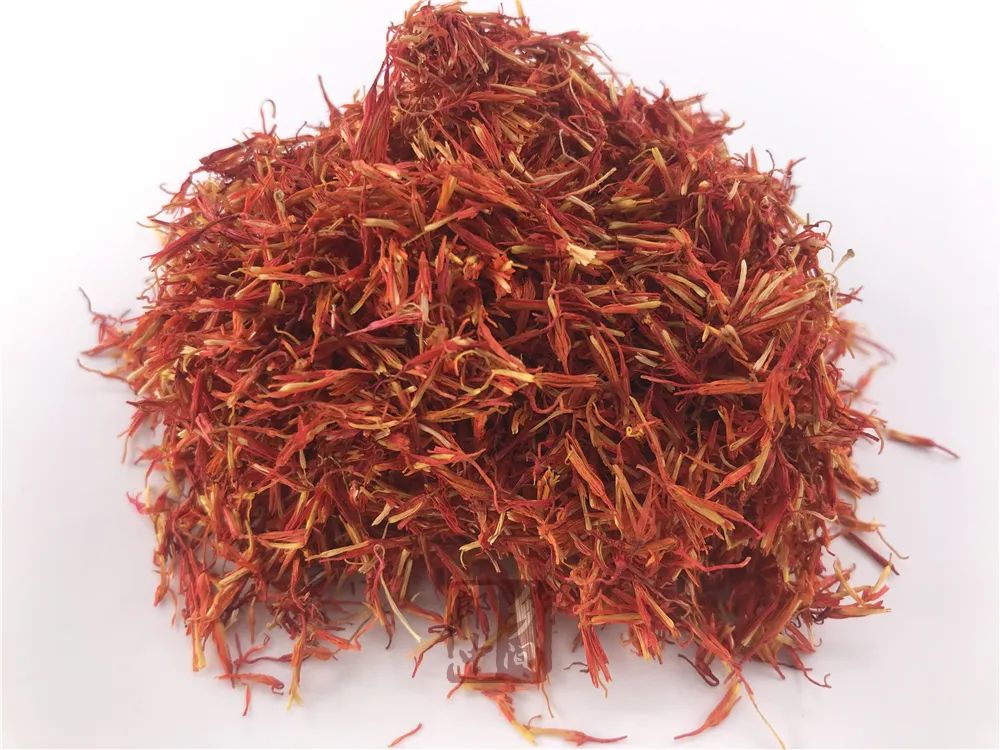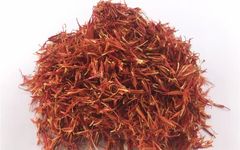Safflower (Hong Hua) is known for its ability to invigorate blood circulation, dispel blood stasis, and has anti-cancer properties. It is also used to promote menstruation, alleviate food stagnation, and relieve pain.
Alias:Du Hong Hua, Huai Hong, Chuan Hong Hua, Cao Hong Hua, Ci Hong Hua, Hong Lan Hua
Taste and Properties:Pungent and bitter, slightly warm in nature.
Meridians Entered:Heart and Liver meridians.
Applicable Constitution:Blood stasis constitution.
Effects and Functions of Safflower
Invigorates blood circulation and regulates menstruation, dispels blood stasis, and relieves pain. It is used for amenorrhea, dysmenorrhea, retained lochia, abdominal masses, chest pain due to blood stasis, abdominal pain from stasis, stabbing pain in the chest and flanks, trauma from falls, and painful sores.
Dosage:3-10g.
Indications:Used for blood stasis-related amenorrhea, dysmenorrhea, postpartum abdominal pain due to stasis. It can be taken alone or combined with other herbs such as Tao Ren (Peach Kernel) and Chuan Xiong (Sichuan Lovage) in formulas like the Peach Blossom Four Substance Decoction. For treating abdominal masses, it is often combined with E Zhu (Curcuma) and San Leng (Sparganium). For rashes with dark colors due to blood heat stagnation, it is commonly used with herbs that clear heat and cool blood, such as Zi Cao (Lithospermum) and Da Qing Ye (Isatis Leaf), as in the Dang Gui Hong Hua Decoction. For chest pain due to blood stasis, it is often combined with Gui Zhi (Cinnamon Twig) and Gua Lou (Trichosanthes Fruit). For abdominal pain from stasis, it is frequently used with Tao Ren and Chuan Xiong, as in the Xue Fu Zhu Yu Decoction. For stabbing pain in the chest or trauma, it can be combined with Tao Ren and Da Huang (Rhubarb), or made into safflower oil or tincture for topical application. It is a commonly used herb for blood stasis conditions.
1. Hemostasis
Safflower can prolong the coagulation time of whole blood, inhibit platelet aggregation, increase fibrinolytic activity, and suppress the formation of blood clots in vitro, thus playing a role in hemostasis.
2. Lipid-lowering
Safflower seed oil contains a high level of linoleic acid, which helps lower blood lipids and serum cholesterol, soften and dilate arteries, prevent atherosclerosis, enhance blood circulation, and regulate the heart and aging endocrine system.
Indications for Safflower
Used for amenorrhea, dysmenorrhea, retained lochia, fetal death in utero, retained placenta, abdominal masses, menstrual vomiting, chest pain due to blood stasis, abdominal pain from stasis, joint pain, trauma, rashes, and painful sores.
This herb invigorates blood and is adept at regulating menstruation, used across various clinical specialties.
In modern practice, it is commonly used to treat menstrual irregularities, retained placenta postpartum, acute and chronic muscle strain, acute joint sprains, cerebral thrombosis, coronary heart disease, duodenal ulcers, flat warts, neurodermatitis, thromboangiitis obliterans, epidemic hemorrhagic fever, infectious hepatitis, thrombosed hemorrhoids, bone hyperplasia syndrome, tibial chondromalacia, and pressure sores.

Contraindications for Safflower
Pregnant women should avoid it. Caution is advised for those with excessive menstruation, ulcer disease, or bleeding tendencies.
When using, attention should be paid to dosage; some believe that “excessive use breaks blood, while minimal use nourishes blood.”
It should not be used in cases of blood deficiency or without stasis.
Long-term excessive use is not recommended.
It should not be used concurrently with Western anticoagulant medications.
① High doses can lead to toxicity, primarily manifesting as abdominal discomfort, abdominal pain, diarrhea, and even gastrointestinal bleeding, abdominal colic, and excessive menstruation; some may experience confusion, tremors, and in severe cases, seizures, with respiratory stimulation followed by depression, leading to circulatory and respiratory failure. A few patients may experience dizziness, rashes, and transient urticaria.
② This herb differs from saffron in origin and function and should be used distinctly.
③ Be cautious of adulterated products that may contain salt, sand, sugar, or other impurities, or those dyed with other flowers or Huang Lian (Coptis).
Methods of Consumption – Benefits of Infusing in Water
Daily Usage:3-8g, decocted in water, but should not exceed 10g.
1. Invigorating Blood and Dispelling Stasis:Combine safflower and green tea in a covered cup, and steep with boiling water. Infuse 3 to 5 times for consumption.
2. Nourishing Blood and Invigorating Blood:12g of safflower, 200g of black beans, and 100g of brown sugar. Decoction of safflower and black beans, remove safflower, add brown sugar, and consume the beans with the soup once daily.
3. Warming the Meridians and Invigorating Blood:10g of safflower and cinnamon, soaked in 500ml of white liquor for one day.
4. Promoting Blood Circulation:A small handful of safflower wrapped in gauze, boiled in water, and used for foot baths twice a day to promote blood circulation.
Selected Formulas with Safflower
1. Alleviating Food Stagnation:6g of safflower, 100g of fresh hawthorn, and appropriate sugar. Clean and core the hawthorn, add water, hawthorn flesh, and safflower to a pot, boil on high heat, then simmer until soft, and add sugar.
2. Invigorating Blood and Regulating Menstruation:6g of safflower, 10g of peach kernel, 50g of rice, and appropriate brown sugar. First, mash the peach kernel into a paste, decoct with safflower, strain, and then cook with rice to make a porridge, adding brown sugar to taste, consumed hot twice daily.
3. Treating Premenstrual Symptoms with Clots and Abdominal Pain:6g of safflower, 9g each of peach kernel, white peony, and angelica, and 12g of cooked rehmannia. Decoct, strain, and consume warm.
4. Treating Dysmenorrhea:9g each of safflower, angelica, raw rehmannia, and achyranthes, 12g of peach kernel, 6g each of bitter orange, red peony, and licorice, 3g of bupleurum, and 45g each of platycodon and chuanxiong. Decoct, strain, and consume warm.
Formula 1: Treating Ulcer Disease
60g of safflower, 60ml of honey, and 10 jujubes. First, boil safflower and jujubes in 400ml of water until reduced to 200ml, remove safflower and add honey. Take 200ml on an empty stomach daily for 20 days as one course, continuing until recovery.
Formula 2: Treating Pressure Sores
500g of safflower boiled in 7000ml of water for about 2 hours until the safflower turns white, then filter the liquid. Continue simmering on low heat for 3-4 hours until it becomes gelatinous. Apply to gauze and cover the affected area, changing the dressing every other day.
Formula 3: Treating Postpartum Abdominal Pain and Constipation
10g each of safflower and cyperus, decoct and consume.
Formula 4: Treating Joint Pain
10g of safflower in 500ml of rice wine, simmer until reduced to 250ml, then strain and consume warm in two doses.
Formula 5: Treating Abdominal Masses
10g each of safflower, peach kernel, angelica, and chuanxiong, decoct and consume.
Formula 6: Treating Erythema
2g of saffron added to 50-100g of lean pork, steamed with appropriate sugar. Consume the meat every other day.
Formula 7: Treating Angina Pectoris
15g each of safflower, red peony, chuanxiong, and aromatic sandalwood, and 30g of salvia, ground into fine powder, divided into three doses, taken daily for 15-30 days.
Formula 8: Treating Dysmenorrhea and Amenorrhea
10g each of safflower, peach kernel, angelica, and white peony, and 12g of cooked rehmannia, decoct and consume.
How to Use Safflower – Dosage and Preparation
Safflower and Chen Pi Decoction
Ingredients:10g each of safflower and Chen Pi
Seasoning:50g of brown sugar
Preparation:Boil safflower and Chen Pi in an appropriate amount of water, then add brown sugar. Divide into two doses, taken for several days.
Health Benefits:Invigorates blood and dispels stasis. Suitable for atherosclerosis with phlegm and stasis obstruction, heaviness in the head, and poor appetite.
Invigorating Blood and Strengthening the Body – Safflower and Perch
One fresh perch, 10g of safflower, appropriate amounts of shredded scallions, salt, sugar, cooking wine, and cornstarch. Clean the perch, soak safflower in boiling water for 15-20 minutes, cut the perch, add cooking wine, salt, and a little safflower. Heat oil in a wok, sauté scallions, add a little broth, and safflower, season with salt and sugar, thicken with cornstarch, and pour over the fish.
Nourishing Blood and Qi – Safflower and Eel
500g of eel, 3g of safflower, 5g of scallions, 10g of ginger, 25g of cooking wine, 4g of salt, 3g of MSG, and 2g of pepper. Cut the eel into slices, boil with scallions and ginger in water, skim off the foam; when the broth turns milky white, add safflower, and after half a minute, remove scallions and ginger, add MSG, and serve.
Nourishing Blood, Invigorating Blood, and Regulating Menstruation – Safflower and Glutinous Rice Porridge
100g of glutinous rice, 10g of angelica, 15g of salvia, and 10g of safflower. Decoct safflower, angelica, and salvia, strain, and add glutinous rice to cook into porridge. This is especially suitable for women preparing for pregnancy.
Supplementing Qi and Blood, Dispelling Stasis – Safflower Steamed Egg
150g of eggs, 10g of safflower, 10g of vegetable oil, 4g of salt, cornstarch, and appropriate chicken broth. Beat eggs in a bowl, add water, salt, and starch, mix well, pour into a glass bowl, and steam until cooked; heat oil, add chicken broth and safflower, boil, and thicken with starch, pour over the egg custard.
Invigorating Blood and Regulating Menstruation – Peach Kernel and Safflower Porridge
15g of peach kernel, 10g of safflower, and 100g of japonica rice. Mash the peach kernel into a paste, decoct with safflower, strain, and cook with japonica rice to make a porridge, adding brown sugar to taste.
Choosing and Storing Safflower
Choose safflower that is bright red, with long petals, soft texture, and free from branches, thorns, and seeds.
Store in a cool, dry place, protecting from pests and moisture.



